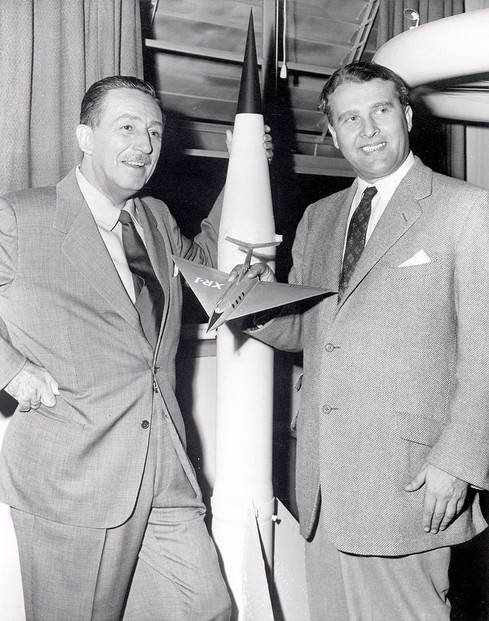Brilliant aerospace engineer Wernher von Braun shared his passion for Mars exploration via book with technical specs for a manned expedition, Das Marsprojekt, published in German in 1952 and in English translation in 1953.
Wernher von Braun welcomes visit on January 1, 1954, from Walt Disney: Dr. Braun served as technical director for three Disney Studio space exploration films in the 1950s.
Marshall Space Flight Center (MSFC), Madison County, northeastern Alabama; January 1, 1954: Public Domain, via Wikimedia Commons @ https://commons.wikimedia.org/wiki/File:Walt_Disney_and_Dr._Wernher_von_Braun_-_GPN-2000-000060.jpg
Some of human concerns about life on Mars include thinner atmosphere, weaker gravity, cosmic and solar radiation.
global mosaic of 102 Viking 1 Orbiter images of Mars taken February 22, 1980, at point perspective projected altitude of 1553 miles (2500 kilometers): Valles Marineris, Mars' largest canyon system (center)
Valles Marineris, largest Martian canyon system (center), and Tharsis Montes, three large shield volcanoes (center left to upper left): NASA/USGS, Public Domain, via Wikimedia Commons @ https://commons.wikimedia.org/wiki/File:Mars_Valles_Marineris.jpeg
Despite atmospheric and other challenges, Mars is deemed as habitable for Earthlings through the process of terraforming ("Earth-shaping").
Rivers feeding hypothesized oceans in artist's conception of terraformed Mars occupy such prominent features as Valles Marineris (center), largest Martian canyon system, and lake fills Aram Chaos, impact crater at eastern end of Valles Marineris.
artist's conception of a terraformed Mars, approximately centered on prime meridian, 30 degrees north latitude: Daein Ballard, CC BY SA 3.0, via Wikimedia Commons @ https://commons.wikimedia.org/wiki/File:TerraformedMarsGlobeRealistic.jpg
Mars' carbon dioxide rich atmosphere freezes at south polar ice cap into 3-feet thick layer atop permanent ice cap of water ice, sandwiched around thin layer of dark sand and dust; spring melt opens vents for trapped gas.
Artist concept shows sand-laden jets of carbon dioxide shoot into sky at Martian south polar ice cap as southern spring begins.
image credit Arizona State University/Ron Miller: NASA's Jet Propulsion Laboratory, Public Domain, via Wikimedia Commons @ https://commons.wikimedia.org/wiki/File:Geysers_on_Mars.jpg; "PIA08660 Sand-Laden Jets (Artist's Concept)," May be used for any purpose without prior permission, via NASA JPL Photojournal @ https://photojournal.jpl.nasa.gov/catalog/PIA08660
Signs of ancient life on Mars? Impact glass (created by meteor striking planetary surface) is found on 3-mile (5 km) central peak of 12-mile (15 km) wide Alga Crater in Mars' southern hemisphere.
color code based on data analysis: green = presence of glass; blues = pyroxene; reds = olivine
detection data from CRISM (Compact Reconnaissance Imaging Spectrometer for Mars) instrument on NASA’s Mars Reconnaissance Orbiter: NASA/JPL-Caltech/JHUAPL/University of Arizona, Public Domain, via Wikimedia Commons @ https://commons.wikimedia.org/wiki/File:PIA19673-Mars-AlgaCrater-ImpactGlassDetected-MRO-20150608.jpg; "PIA19673 Spectral Signals Indicating Impact Glass on Mars," May be used for any purpose without prior permission, via NASA JPL Photojournal @ https://photojournal.jpl.nasa.gov/catalog/PIA19673
"Your kids might live on Mars. Here's how they'll survive | Stephen Petranek" (17:14)
Uploaded May 5, 2016, by TED to YouTube ~ URL: https://www.youtube.com/watch?v=t9c7aheZxls














 Are Hawaiian Huakai Po Nightmarchers Avenging Halloween Thursday?on 10/02/2024
Are Hawaiian Huakai Po Nightmarchers Avenging Halloween Thursday?on 10/02/2024
 Mailing Addresses for 2023 Form 4868 Extending 1040 and 1040SR April 15, 2024, Due Dateon 04/15/2024
Mailing Addresses for 2023 Form 4868 Extending 1040 and 1040SR April 15, 2024, Due Dateon 04/15/2024
 Mailing Addresses for 2023 Forms 1040 and 1040SR Filed in 2024on 04/15/2024
Mailing Addresses for 2023 Forms 1040 and 1040SR Filed in 2024on 04/15/2024
 Mailing Addresses for 2022 Form 4868 Extending 1040 and 1040SR April 18, 2023, Due Dateon 04/13/2023
Mailing Addresses for 2022 Form 4868 Extending 1040 and 1040SR April 18, 2023, Due Dateon 04/13/2023



Comments